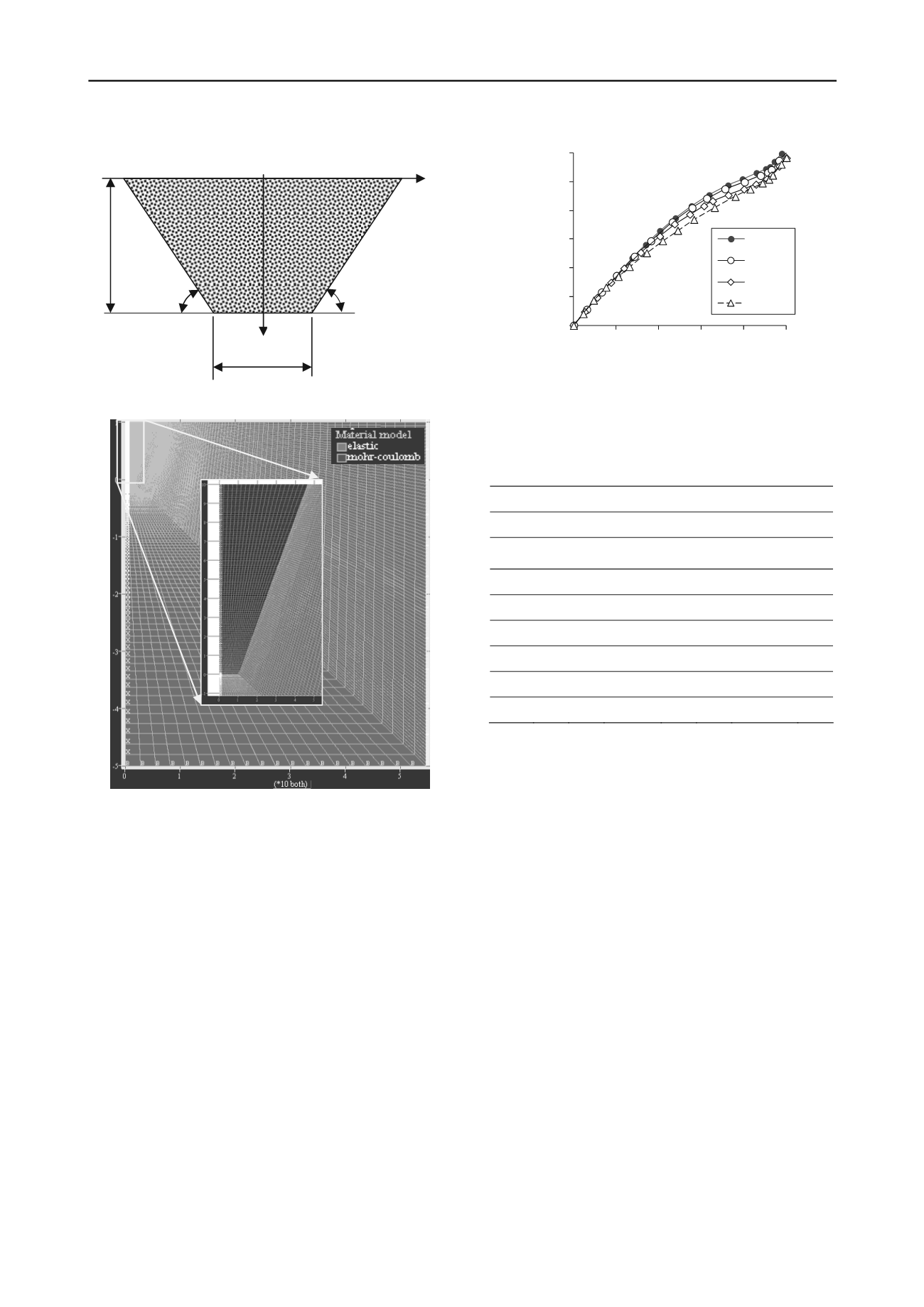
1748
Proceedings of the 18
th
International Conference on Soil Mechanics and Geotechnical Engineering, Paris 2013
elastic, described by
E
r
(Young’s modulus),
r
(Poisson’s ratio),
and
r
(unit weight).
Figure 1. Geometry of the backfilled trench with inclined walls.
Figure 2. Model discretization of the trench with an enlarged view.
Figure 2 shows a typical discretization used for numerical
modeling with FLAC; symmetry is taken into account so that
only half of the trench is considered. The numerical simulation
is performed in steps, with the excavation of the trench being
completed at first. The trench is then filled in layers, after initial
walls displacements.
Figure 3 shows the vertical stress distribution along the
vertical central line (VCL) when the number of filling layers
varies from 1 to 20 (to attain the full height
H
b
). It is noted that
the stress magnitude increases slightly when the number of
layers goes from 1 to 10. The stress is about the same for 10 or
20 layers. In the following, all simulations are performed with
10 layers of filling (i.e. 1 m / layer).
Table 1 presents details of the numerical simulations
conducted to investigate influencing factors related to the trench
geometry and properties of the backfill, which may affect the
vertical stress distribution along the VCL of inclined walls
3 VERTICAL STRESS DISTRIBUTION
In this section, the influence of the trench geometry, properties
of the backfill, is assessed in term of the vertical stress
distribution along the VCL.
0
20
40
60
80
100
120
0
2
4
6
8
1
v
(kPa)
h
(m)
x
0
20 layers
10 layers
5 layers
1 layer
H
b
h
L
b
Figure 3. Vertical stress distribution along the vertical central line
(VCL) of the trench with different filling layer number; details are given
in Table 1.
Table 1. Details of the numerical simulations conducted for
investigating influence factors. Other properties include
γ
b
=
18 kN/m
3
for the backfill;
E
r
= 30 GPa,
r
= 0.25, and
r
= 27 kN/m
3
for the linear
lastic material forming the two walls.
e
Fig.
L
b
c'
b
(kPa)
'
b
'
b
E
b
(MPa)
b
3
70° 2 m
0
30°
0
200
0.2
4
†
var
‡
2 m
0
30°
0
200
0.2
5
†
70° var
‡
0
30°
0
200
0.2
6
†
70° 2 m
var
‡
30°
0
200
0.2
7
†
70° 2 m
0
var
‡
0
200
0.2
8
†
70° 2 m
0
30° var
‡
200
0.2
9
†
70° 2 m
0
30°
0
var
‡
0.2
10
†
70° 2 m
0
30°
0
200
var
‡
†
simulation performed with 10 layers of filling;
‡
var = varying value.
3.1
Effect of trench geometry
3.1.1
Wall inclination
Figure 4 shows the variation of the vertical stress distribution
along the VCL with the wall inclination angle
. One sees that
the stress magnitude increases when the wall inclination angle
decreases from 90° (vertical trench) to 20°. The vertical
pressures obtained by the numerical modeling remain below the
linear vertical stress distribution calculated from the overburden
(i.e.
v
= γ
b
h
), indicating the occurrence of some arching effect.
These results shown in Fig. 4 are not unexpected. Keeping
the width at the base of the trench (
L
b
) constant, a decrease in
the wall inclination angle (
) leads to an increase of the trench
width in the upper part. This tends to decrease the arching effect
and leads to an increase in the vertical stresses in the backfill.
These results also indicate that the direct application of Marston
(1930) solution to a trench with inclined walls would tend to
underestimate the loads on the conduits, leading to non
conservative design (Li et al. 2012a,b).
All other calculations are performed with
= 70°.
3.1.2
Trench width
Figure 5 presents the vertical stress distributions obtained from
the simulations along the VCL for different width at the base of
the trench (
L
b
). Without any surprise, it is seen that an increase
of width
L
b
leads to a significant increase in the vertical stresses
in the backfill.


